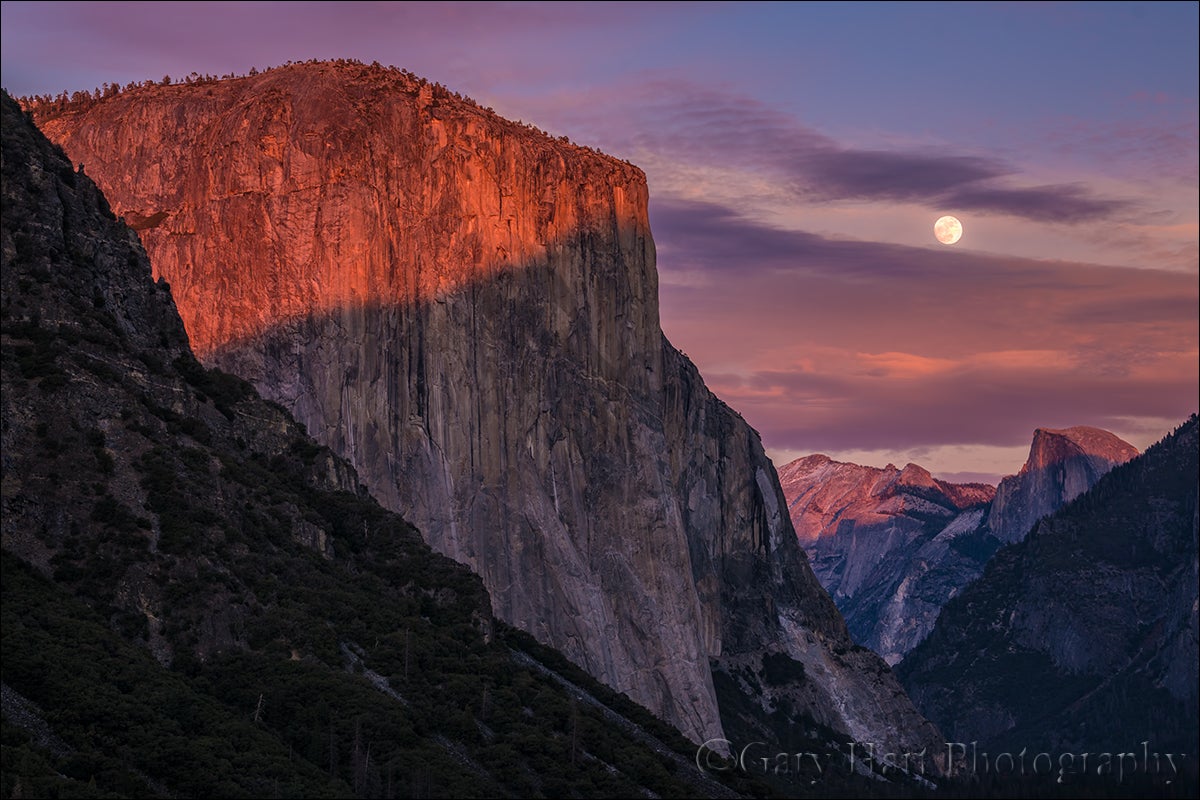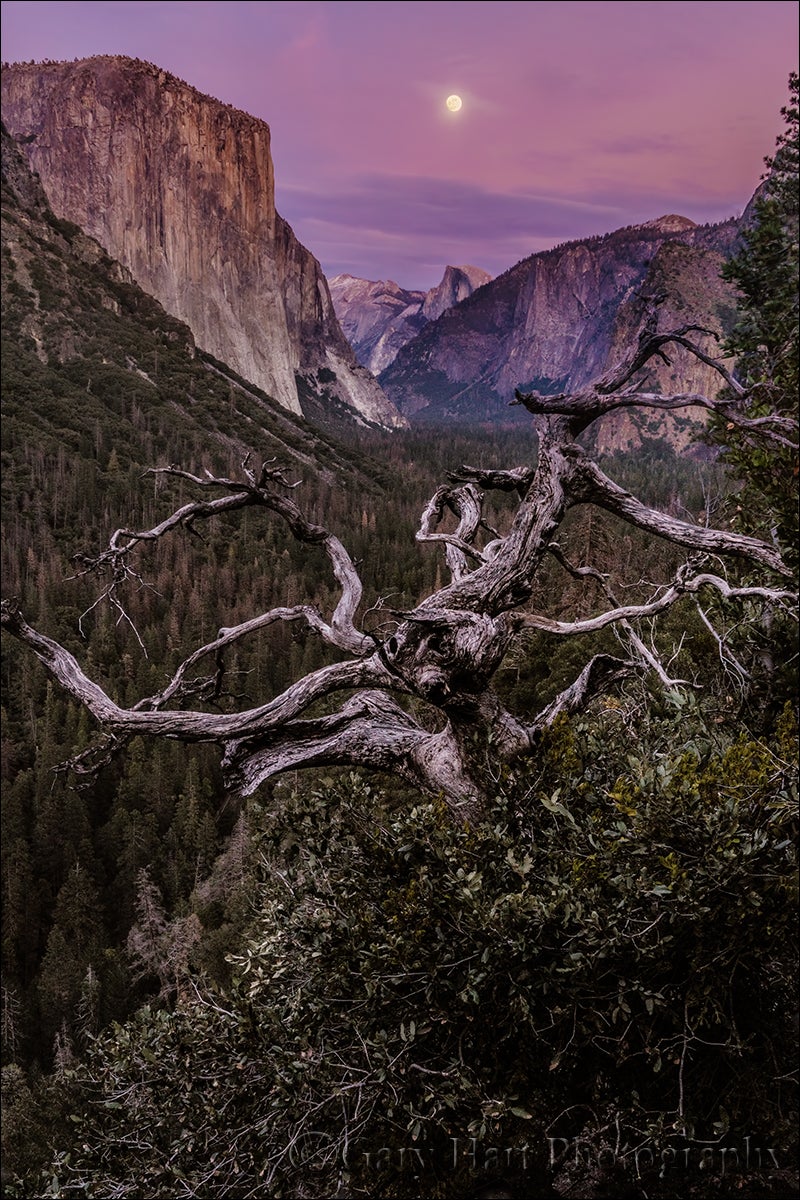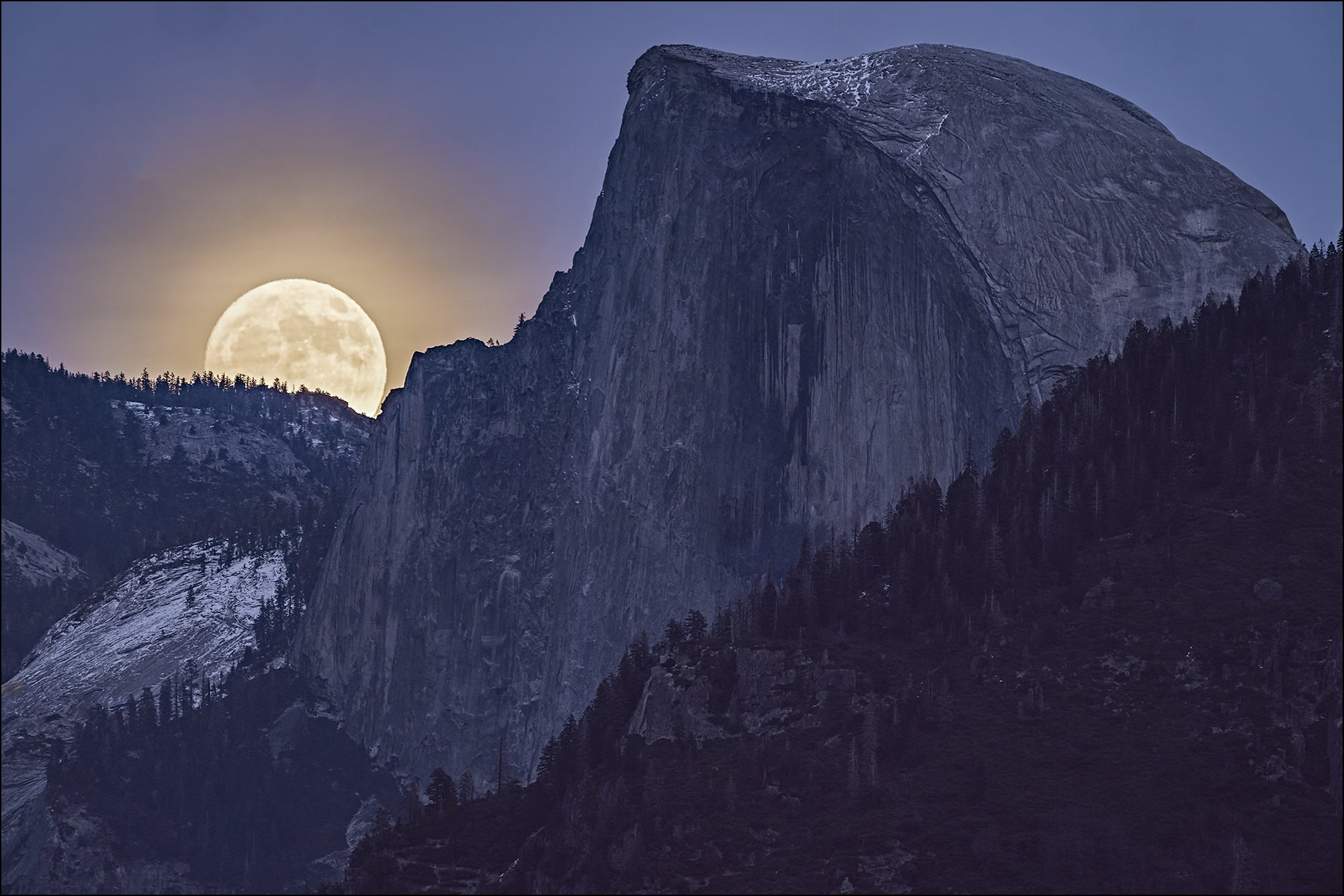Every full moon is special, but the full moon we’ll see on Wednesday, January 31, will be extra special. A rare orbital and calendar convergence makes Wednesday’s full moon a “super blue blood moon,” a lunar trifecta that hasn’t happened in over 150 years. If you’re like me, understanding your subjects doesn’t just improve your photography, it also enhances your enjoyment of nature.
A Little Lunar Geometry
Just as the Earth revolves around the sun, the moon revolves around Earth; at any point in this celestial dance, half of Earth is daylight and half is night, while half of the moon is lit and half is dark. The amount of the moon we see (its phase) depends on the relative position of the sun, moon and Earth in this dance, and once each month all of the sunlit side of the moon faces the dark side of Earth, and we Earthlings enjoy a full moon.
This alignment of three or more orbiting celestial bodies necessary for a full (and new) moon is called ‘syzygy.’ The sun, Earth and moon achieve syzygy twice each lunar month: once when the moon is between the sun and Earth (a new moon), and again when Earth is between the sun and moon (a full moon).
The moon completes a full trip around Earth every 27.3 days, but it takes 29.5 days to cycle through all its phases, from new to full and back to new again. The moon’s phases need an extra 2+ days because as the moon circles Earth, Earth also circles the sun, moving the syzygy point with it—imagine a race with a moving finish line.
Because the sun and a full moon are on opposite sides of the sky as viewed from Earth, a full moon rises in the east at sunset and sets in the west at sunrise. We rarely see a full moon rising exactly as the sun sets (or setting as the sun rises) because: 1) the point of maximum fullness (when the sun, Earth and moon align perfectly) only happens at one instant on the full moon day—at every other instant of each month’s full moon day, the moon is merely almost full (but still full enough to appear full); 2) published sun/moon rise/set times assume a flat horizon—if you have mountains between you and the horizon, your view of the true sun/moon rise/set is blocked; and 3) The more extreme your latitude (angular distance from the equator), the more skewed the sun/moon alignment appears.
Armed with this knowledge, it makes sense that the closer the moon is to full, the longer it’s in the night sky; a full moon is in the sky all night long. Less intuitive but very important for lunar photographers to know, each day the moon rises an average of 50 minutes later (between 30-70 minutes) than it rose the previous day—I usually mentally round to an hour for quick figuring.

January 2, 2018 supermoon. Sony α7R II. Sony 70-200mm f/4 lens. 1/10-sec., f/8, ISO 200
Supermoon
To understand what a supermoon is, you first have to understand that orbiting celestial bodies travel in an ellipse, not a circle. That's because objects in an orbital relationship (such as the moon and Earth) each have a gravitational influence on the other. Without getting too deep into the gravitational weeds, let's just say that this mutual influence causes the moon’s orbit to deviate ever so slightly from the circular path we perceive it to follow: an ellipse. And because an ellipse isn't perfectly round, the moon’s distance from Earth varies as it orbits.
An orbiting object's closest approach to the center of its ellipse (and the object it orbits) is ‘perigee’; its greatest distance from the ellipse's center is ‘apogee.’ While perigee, apogee and period are precise terms that can be measured to the microsecond, a supermoon is a non-scientific, media-fueled phenomenon loosely labeled as a moon that happens to be near perigee when it's full.
The rather arbitrary consensus supermoon definition is: a full moon that is within 90 percent of its closest approach to Earth. Using that definition, a full moon at perigee (the largest possible supermoon) will appear about 14 percent larger and 30 percent brighter than a full moon at apogee (the smallest possible moon). To put this in terms everyone can grasp, if your favorite pizzeria gives you a coupon to supersize your regular 12-inch pizza by 14 percent, that upgraded pizza will be a whopping 12.8 inches. (But sadly, it won’t be 30 percent tastier.)
Lunar Eclipse
A solar eclipse like the United States experienced last August happens when the moon’s shadow passes across the Earth’s surface; a lunar eclipse happens when the moon moves into Earth’s shadow. If the sun, Earth and moon were always on the same plane, we’d have an eclipse with each syzygy: with every new moon we’d have a solar eclipse, and every full moon would feature a lunar eclipse. But the moon’s orbit is tilted about 5 degrees from Earth’s orbit, making the perfect alignment an eclipse requires relatively rare. The perfect alignment of the sun, Earth and moon necessary for a lunar eclipse happens from two to four times each year.
One of those alignments happens for most of North America, Asia and Australia (and parts of other continents) next Wednesday, January 31. As Earth’s shadow advances across the moon’s face, the moon will start to disappear. At totality, most of the sunlight illuminating the moon is blocked by Earth. The remaining light has to pass through Earth’s atmosphere, which filters out all but the long, red wavelengths. For the same reason sunsets are red, during a total lunar eclipse we see a red or “blood” moon.
Blue Moon
Despite its colorful name, there’s nothing visually unique about a blue moon. And after all the orbital stuff I’ve subjected you to, this one’s easy: A “blue moon” is simply the second full moon in a calendar month. Given that the lunar cycle is about 29.5 days, and most months have 30 or 31 days, it stands to reason that a blue moon will happen from time to time. While it turns out that we average a blue moon about once every two-and-a-half years, we’ll only need to wait until March for the next one. But the March blue moon won’t be super, nor will it be eclipsed.

In early January of 2018 Gary Hart photographed the "most super" of the three consecutive supermoons occurring in December 2017 through the end of January 2018. Although his effort to create an image with the huge moon coming off the horizon were stymied, he made this beautiful "magenta moon" photo. See the full story of this photo on his blog. Sony α7R III. Sony 24-70mm f/4 lens. 0.8-sec., f/1, ISO 100.
Locating The Moon
If the idea of computing anything saps the pleasure from your photography, today there’s hope for aspiring moon photographers. Moon phase and rise/set times are available online and in many smartphone apps, just a Google search away. For more detailed information, apps such as The Photographer’s Ephemeris and Photo Pills (to name just two of many) will actually plot the angle and timing of the sun’s and moon’s rise and set from any location on Earth, even taking terrain into account.
On the other hand, if you don’t care about photographing the moon above a particular landscape feature, just go outside and look up. Before midnight it will be in the east; after midnight you’ll find it in the west. If it’s the eclipse you’re looking for, check the times for your location. In the Western Hemisphere it will be a little before sunrise, with the viewing better the farther west you are. There’s a good zoomable, clickable resource for Wednesday’s eclipse at timeanddate.com.
The Size Of The Moon
Many photographers are frustrated that the moon appears so large in person, but so small in an image. This is an illusion—the size of the moon in your frame is almost entirely a function of your focal length. But rather than letting the moon’s small appearance discourage you, use it as an accent to further enhance an already nice scene.
Photographers who set out to photograph a supermoon believing that’s the secret to a large moon will be extremely disappointed (see pizza reference above). If you want the moon (super or not) large above your landscape, find a foreground subject that can be viewed at a great enough distance to be photographed with an extreme telephoto, then use an app to determine the location where the rising or setting moon aligns with your subject, and the time it will happen.
One of my favorite locations for this is Tunnel View in Yosemite, where I can use a 400mm lens to fill my frame with Half Dome and still fit the moon. This is where the homework comes in, because there are only a couple of months each year where the full moon aligns with Half Dome from Tunnel View.
 Yosemite Supermoon and Half Dome photographed from Tunnel View, Yosemite National Park, CA. December 2, 2017. Sony α7R III. Sony 100-400mm f/4.5-5.6 G Master lens with Sony 2x teleconverter. 1/8-sec., f/11, ISO 400.
Yosemite Supermoon and Half Dome photographed from Tunnel View, Yosemite National Park, CA. December 2, 2017. Sony α7R III. Sony 100-400mm f/4.5-5.6 G Master lens with Sony 2x teleconverter. 1/8-sec., f/11, ISO 400.
Exposure
My rule for photographing a rising/setting full moon is that I must capture detail in the landscape and the moon. Since the post-sunset landscape is in full shade, and the moon is as bright as a sunlit landscape (because it is a sunlit landscape), the dynamic range of a full moon scene is pretty extreme, often too extreme for a camera to handle with a single click (always my goal). If my landscape is black (or just too dark), or my moon is a white disk (or blob), my image has failed.
The more dynamic range your camera has, the better your full moon photography will be. The Sony α7R III (and its predecessor, the α7R II) have the most dynamic range of any camera I’ve ever shot with, allowing me to get moon images I never imagined possible.
Regardless of your camera, here’s the secret to getting the most out of your moonrise and moonset images: Given that the moon rises about an hour later each day, and the full moon rises around sunset, it stands to reason that the day before it’s full, the moon will rise before the sun sets. Factoring in the terrain on the horizon (and assuming you’re not at the base of a mountain that forces you to look straight up to see the sky), that means that the day before the moon is full is usually the best opportunity to photograph a nearly full (say 98 percent, give or take a percent or two) moon rising in the east above a landscape painted with the warm sunlight. Conversely, if your view is to the west, you can photograph a nearly full moon setting above a scene bathed in warm sunrise light the day after it’s full.
I’ve found that if I’m really careful with my exposure, my Sony α7R III can capture foreground and lunar detail in one frame until 15 minutes after sunset. Shooting after sunset usually requires raw capture, then massaging the dark foreground brighter, and bright moon darker, in the raw processor. A graduated neutral density filter can add five or ten minutes to your window of opportunity—after that my foreground is unusably dark (or my moon is recoverably bright).
Another technique that works when the light gets too extreme is a composite—two images, one exposed for the landscape and the other exposed for the moon, combined in Photoshop. In the “Rules According to Gary,” this isn’t cheating if you don’t change the size or position of the moon. (While it doesn’t break my rules, I no longer do composites because I have this weird compulsion to get everything with one click.)
The final piece of exposure advice I’ll add is to make sure your camera’s zebra warning (if you’re using Sony mirrorless) and blinking highlights (also called highlight alert) are turned on. The moon is usually so small in your frame that it won’t register in the histogram, which means the pre-capture zebra alert and post-capture blinking highlights are the only way to know that you’ve blown out the moon.
I monitor my highlights closely after each exposure and have found that, when shooting raw (jpeg shooters don’t have as much margin for error), I can usually recover enough detail with an exposure 2/3 to 1 stop beyond where the warning first appears. Once I’ve reached the maximum lunar exposure, I keep shooting until the foreground becomes too dark to recover usable detail.
My Super Blue Blood Moon Plans
I’ve scheduled a workshop in Death Valley to coincide with this month’s supermoon. I already have the group’s locations picked for the lunar eclipse shortly before sunrise on January 31, and for the sunrise moonset on February 1.
We’ll then travel to the Alabama Hills near Lone Pine to photograph another sunrise moonset behind Mt. Whitney on February 2. Even though the moon will set about 40 minutes later on February 2 (assuming a flat horizon), a second sunrise moonset will be possible because the towering Sierra crest makes the horizon much higher in the Alabama Hills that it will be from our Death Valley location.
I’ll be armed with my Sony α7R III, and will probably use an array of lenses, from the Sony 24-70mm f/4, to the Sony 70-200mm f/4 G, to the Sony 100-400mm f/4.5-5.6 GM. If the conditions are especially spectacular, I may also set up my Sony α7R II on a second tripod and shoot both wide and long simultaneously.
Gary Hart is a Sony Artisan Of Imagery. See more about him here. Follow his EloquentNature blog and sign up for his workshops here.



